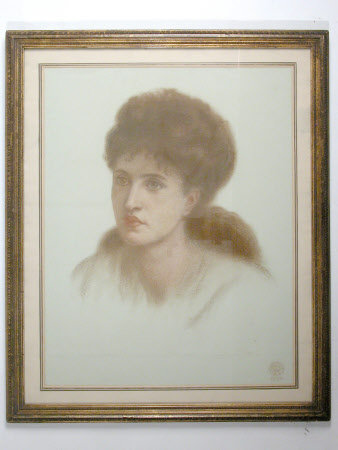Maria Cassavetti, Mrs Zambaco (1843-1914)
Dante Gabriel Rossetti (London 1828 - Birchington 1882)
Category
Art / Drawings and watercolours
Date
1870 (monogrammed and dated)
Materials
Coloured chalks on paper
Measurements
580 x 455 mm
Order this imageCollection
Wightwick Manor, West Midlands
NT 1287931
Summary
Coloured chalks drawing on pale green green paper, Maria Cassavetti, Mrs Zambaco (1843-1914) by Dante Gabriel Rossetti (London 1828 - Birchington 1882), signed with monogram and dated 1870. A head portrait of Maria Zambaco, slightly to left with brown hair gathered at the nape of neck.
Full description
This is characteristic of the sensuous images of women which dominate Rossetti's work of the 1860s and 1870s. As in the majority of these the head is turned to one side to combine profile and full face, and the firmly modelled drawing emphasises the prominent "cupid's bow" mouth, eyes, long neck and abundant hair, all creating the distinctive 'Rossetti look'. The technique of chalks, often as here on green / blue paper, was used by Rossetti a great deal from 1868 onwards. Maria (also known as Mary) Zambaco (1843-1914) is chiefly known as Burne-Jones' lover, but her own artistic career has been largely ignored. She was born into the Greek community in London. Her father was Dimitrius Cassavetti ('Hadji'), a wealthy cotton merchant. Her mother Euphrosyne was a member of the leading family, the Ionides, who were great patrons of the arts. Maria's Ionides cousins included the art collector Constantine, patron of Burne-Jones and Rossetti, Alexander, patron of Morris and Co., and Luke and Aglaia (Mrs Coronio), friends of Morris and Burne-Jones, and Ionides connections included the Spartalis. Maria, Aglaia and Marie Spartali appear together as the Three Graces in Burne-Jones' The Mill (1870-82), commissioned by Constantine. Maria was passionate and unconventional; in 1860 George Du Maurier described her as "rude and unapproachable but of great talent and really wonderful beauty". Her cousin A.C. Ionides later described "her glorious red hair and almost phosphorescent white skin". In 1861 she married Dimitrius-Alexander Zambaco (or Zambacos), doctor to the Greek community in Paris. In 1866 Maria left her husband and returned to London with her son and daughter. Her mother introduced her to Burne-Jones. It was the beginning of a tempestuous relationship which threw Burne-Jones's marriage into crisis. Burne-Jones later described her: "It was a wonderful head, neither profile was quite like the other - and the full face was different again." In 1868 Burne-Jones began trying to end the relationship. On a January night in 1869 Maria proposed a suicide pact and when Burne-Jones refused she attempted to throw herself into the Regent's Canal outside Robert Browning's house. The police arrived to find Burne-Jones struggling with her. Burne-Jones left London with Morris, leaving Maria, as Rossetti put it "beating up all the quarters of his friends for him, and howling like Cassandra." Maria would not accept the parting, and Burne-Jones' continuing obsession with her is reflected in many pictures and drawings. On 4 March 1870 he wrote to Jane Morris:"....I think I have made a good portrait of Mary Zambaco, & Ned [Burne-Jones] is greatly delighted with it....I like her very much and am sure that her love is all in all to her. I never had an opportunity of understanding her before....she is really extremely beautiful herself when one gets to study her face. I think she has got much more so within the last year with all her love and trouble." The troubled relationship finally ended in 1872. Maria became ill, possibly suffering a breakdown. When she recovered she decided to return to Paris. She had already begun to paint, possibly taught by Burne-Jones. In 1879 Rossetti wrote to Jane Morris "Marie [Stillman] told me that Mary Z. and her little pseudo-husband do nothing but work awfully hard at painting and produce Ned Joneses without number." In the early 1880s she returned (alone) to London. She took up sculpture under the tuition of Alphonse Legros. Her first works were exhibited at the Royal Academy in 1886. Under his influence in 1885 she began making cast bronze portrait medals, including one of Marie Stillman (1886, British Museum), which she exhibited in London and Paris. A friendship with the sculptor Rodin began, and in the 1890s she returned once more to Paris, where Rodin gave her help and encouragement with her work. She ceased exhibiting after 1900. (Adapted from author's unpublished property catalogue, Stephen Ponder, Wightwick Manor, circa 1995)
Provenance
Sotheby's 15 July 1959, lot 55 (as Head of a Young Woman), purchased by Sir Geoffrey Mander, £35.
Marks and inscriptions
DGR (monogram) 1870 (signed and dated bottom right)
Makers and roles
Dante Gabriel Rossetti (London 1828 - Birchington 1882), artist
References
Bryson, 1976: John Bryson (ed.). Dante Gabriel Rossetti and Jane Morris: Their Correspondence 1976, p. 36 Surtees 1971 Virginia Surtees, The Paintings and Drawings of Dante Gabriel Rossetti (1828 - 1882). A Catalogue Raisonné, 2 vols., Oxford 1971, 543 Marsh & Nunn 1997 Jan Marsh and Pamela Gerrish Nunn, Pre-Raphaelite Women Artists, (exh. cat.) Manchester City Art Gallery, 1997, ill. p 136. Stewart (ed.) 2018: Claire Stewart (ed.), Lowry & the Pre-Raphaelites (exh. cat.), Lowry Press: Salford, 2018.
